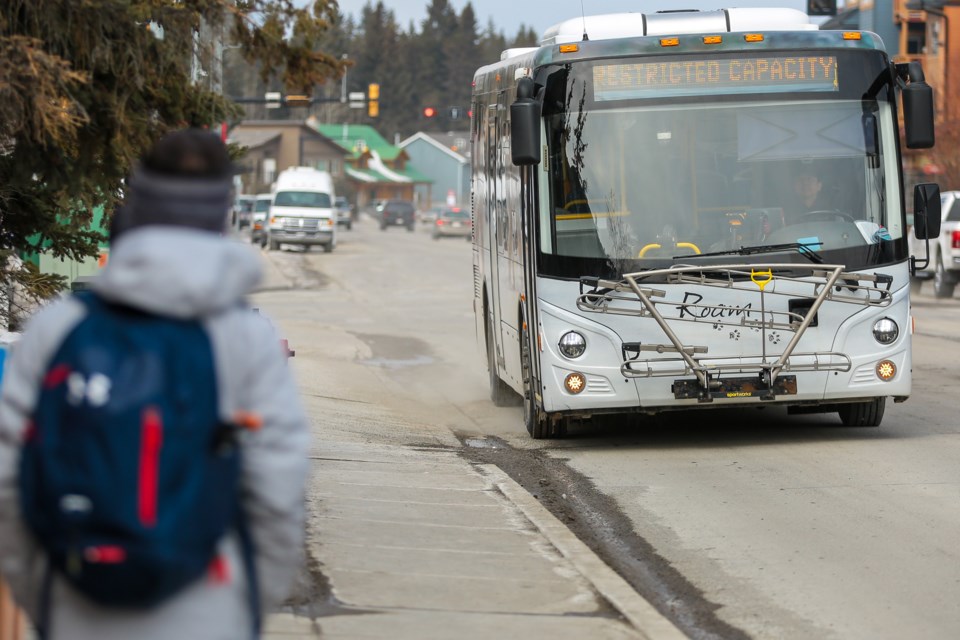BOW VALLEY – Hard hit by the COVID-19 pandemic, Roam transit’s coffers are being replenished to help with lost revenues.
The Bow Valley Regional Transit Services Commission (BVRTSC) will receive $1.16 million as part of the Alberta Relief for Shortfalls for Transit Operators (RESTOR). The initiative is a 50-50 split between the Alberta and federal governments, totalling about $159 million.
At the April 13 BVRTSC meeting, Roam CEO Martin Bean said it was a promising shot of funding to help the transit service.
“We’re getting noticed for providing excellent transit service and our move towards electrification and zero emissions," he said. "It was really good and we’ll continue to see growth as we move forward.”
The funding was determined based on 2019 ridership statistics, and can be used to address revenue shortfalls from Oct. 2021 to the end of 2022, or transit capital projects. Under the terms of the agreement, the money has to be used by March 2023.
Bean said there were roughly 1.5 million riders in 2019, but the pandemic saw ridership slashed by about 80 per cent.
While local ridership numbers have rebounded, he said the funding was critical to Roam.
“To keep this part of Alberta environmentally sustainable, we strive to enable residents and visitors to move throughout the Bow Valley without the use of a private vehicle,” Bean said.
Roughly 70 per cent of ridership has returned to pre-pandemic numbers. As of March, Canmore route 5 had a 27 per cent increase (9,579 to 12,155 riders) compared to March 2019. Route 8 also had a 30 per cent increase for the same time period and routes 1, 2 and 3 had a decrease between 10 to 37 per cent.
Compared to March 2021 to March 2022, statistics show an increase between 41 and 219 per cent on all routes.
Earlier in April, the Canmore route 5 split into a 5c (Cougar Creek) and 5t (Three Sisters) to improve service on both sides of the Trans-Canada Highway. Banff will also introduce fare free transit for residents on May 20.
The BVRTSC board also passed a motion to annually review driver compensation in an attempt to address what has been a struggle in some years to find seasonal drivers.
With the majority of businesses in the Bow Valley struggling to hire staff, Roam is no different. Bean said the service will have enough drivers for its routes but may have to tap into voluntary overtime.
Last summer saw many drivers come over from tourism-related driving, but with services back up and running, it was less so this year. Bean said drivers in large cities can make $40 or more an hour, while those for tourism companies can make significantly more than with Roam with a wage and tips.
Joanna McCallum, the board’s chair, said by annually reviewing driver wages it “builds trust” between the employee and employer to keep an “open, clear and conducive to a good relationship.”
At an April 13 media conference in Calgary, Premier Jason Kenney said it was a necessity to help transit services that were heavily impacted by the pandemic.
“Transit systems took a financial beating during the pandemic with a significant loss in ridership as people worked from home and businesses cut back on staff or completely shut down," he said. "This funding will keep buses and trains moving to meet increased demand as we recover from the pandemic.”
More than half of the funding – $82.3 million – is going to Calgary Transit, which was projected to have an $89 million revenue shortfall this year. The City of Edmonton is receiving $66.9 million.
The funding is doled out to 26 municipalities, including nearby Cochrane, Airdrie, Rocky View County and Okotoks.
“It’s obviously very welcome news and it feels like Roam’s been leading the charge with good news lately, so really happy to hear about this,” said Banff Mayor Corrie DiManno, who is a commission member representing the Town of Banff.
The 1.16 million is broken up between the three member municipalities with 44 per cent ($507,286) for Banff, 36 per cent ($414,878) for Canmore and 21 per cent ($240,257) for Improvement District No. 9.
“The pandemic created challenges for all and every part of life and transit’s been no exception," Bean said. "Our focus continues to be keeping service levels convenient and consistent while ensuring safety for our passengers and our staff."




